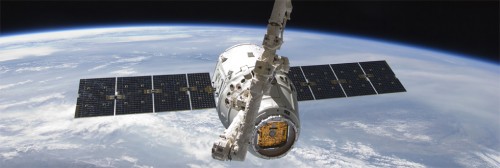Dragon is the first commercially owned spacecraft to successfully attach to the International Space Station in orbit around Earth. Developed by SpaceX under NASA’s Commercial Orbital Transportation Services (COTS) program, this “free-flying” ship has begun regularly supplying the Space Station, including recently with fresh fruit.
 Last week The Dragon capsule delivered over 2,3000 pounds to the Space Station and brought 3,000 pounds back. Science equipment, clothing, food and other needed supplies are delivered, while trash, things that can’t be repaired at the station, and experiments get shipped back to Earth.
Last week The Dragon capsule delivered over 2,3000 pounds to the Space Station and brought 3,000 pounds back. Science equipment, clothing, food and other needed supplies are delivered, while trash, things that can’t be repaired at the station, and experiments get shipped back to Earth.
The Dragon spacecraft is built to withstand the extreme pressures and heat that occur when entering and exiting our atmosphere. As you’ll see from the specs below on The Dragon from the official SpaceX website, every care has been taken to protect the lives and cargo that gets shot into space, whether the destination be the International Space Station, or to test equipment and do other experiments in space.
SpaceX isn’t the only company who has built a “space freighter”. Orbital Sciences Corp wants to get in on the action too, and theirs should be up and running within the year.
I wonder how long it will be before the average, Earth inhabitant can fork out the cash to take a dip into space on one of these freighters? Better yet: who will be the first to market a commercial, personal ship? It’s possible, it’s right there, just around the corner.
The future is now.
~CHa0s
Dragon Highlights:
- Fully autonomous rendezvous and docking with manual override capability in crewed configuration
- 6,000 kg (13,228 lbs) payload up-mass to LEO; 3,000 kg (6,614 lbs) payload down-mass
- Payload Volume: 10 m3 (350 ft3) pressurized, 14 m3 (490 ft3) unpressurized
- Dragon is 4.4 meters (14.4 feet) tall and 3.66 meters (12 feet) in diameter.
- The trunk is 2.8 meters (9.2 feet) tall and 3.66 meters (12 feet) wide. With the solar panels fully extended, the vehicle measures 16.5 meters (54 feet) wide.
- Supports up to 7 passengers in Crew configuration
Draco Thrusters
- Eighteen Draco thrusters used for orbital maneuvering and attitude control (providing system redundancy).
- Powered by nitrogen tetroxide / monomethylhydrazine (NTO/MMH) storable propellants
- 90 lbf (400 N) thrust used for on-orbit maneuvering, de-orbit burns, and re-entry attitude
Thermal Protection System
- Dragon has the most powerful heat shield in the world; designed in cooperation with NASA, it is made of a material called PICA-X, a high performance variant on NASA ’s original Phenolic Impregnated Carbon Ablator (PICA).
- Backshell protected by SpaceX’s Proprietary Ablative Material (SPAM).
Power
- Two solar array wings on trunk (8 panels total) for power.
Avionics
- Two-fault tolerant avionics system with extensive heritage
Environmental Control System
- Provides a habitable cabin: Air circulation, fire detection and suppression, lights.
- Pressure control, pressure and humidity monitoring.
Re-entry
- Designed for water landing under parachute for ocean recovery
- Designed for lift during reentry for precise landing and low g-forces.
Transporting Crew
To ensure a rapid transition from cargo to crew capability, the cargo and crew configurations of Dragon are almost identical, with the exception of the crew escape system, the life support system and onboard controls that allow the crew to take over control from the flight computer when needed. This focus on commonality minimizes the design effort and simplifies the human rating process, allowing systems critical to Dragon crew safety and space station safety to be fully tested on unmanned demonstration flights and cargo resupply missions
For cargo launches the inside of the spacecraft is outfitted with a modular cargo rack system designed to accommodate pressurized cargo in standard sizes and form factors. For crewed launches, the interior is outfitted with crew couches, controls with manual override capability and upgraded life-support.



